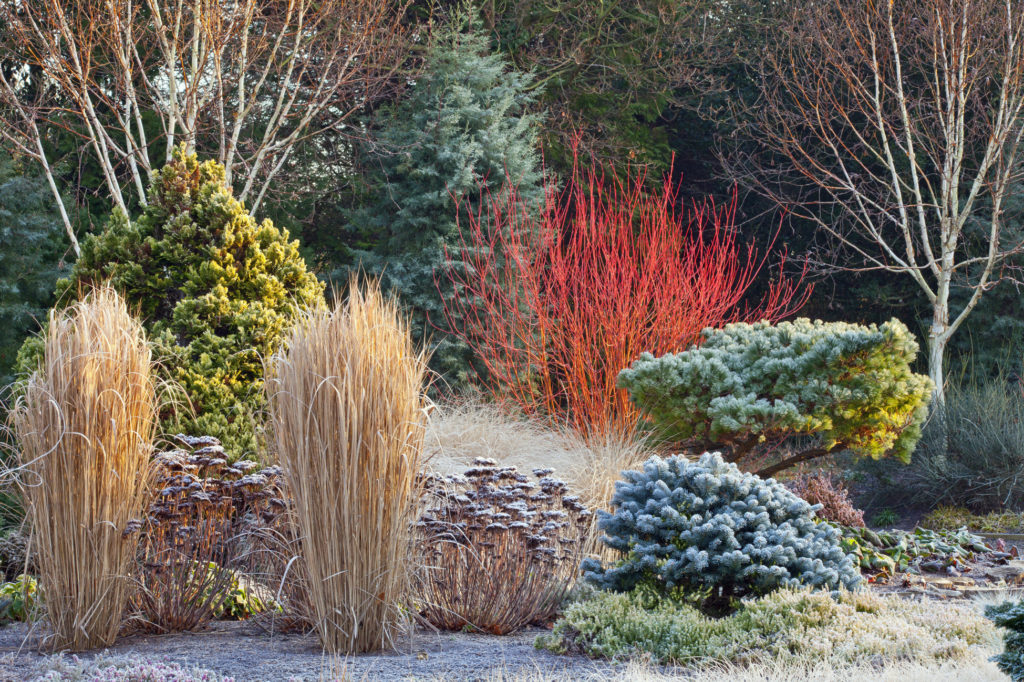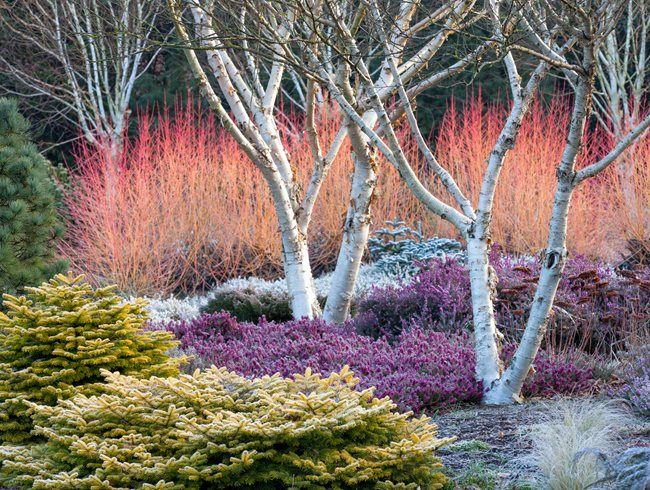Check out our progress on the turf-to-habitat project in Seekonk, MA, like it if you like it and subscribe it you want to know more about native plant design and consulting in SE MA.
Tag Archives: Native plants
RESPECT YOUR ELDERS!
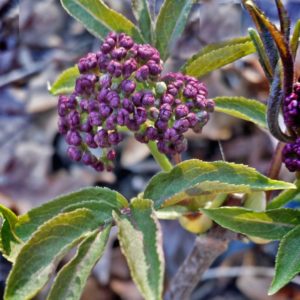
Native red elderberry plant, Sambucus racemosa, showing off its flower buds in the Garden-911 display garden in North Easton, MA. WARNING: Red elderberry fruit, leaves, stems, flowers, roots and other tissue are known to be toxic when taken internally without sufficient preparation. Carol Lundeen and Garden-911 assume no liability if you choose to eat or allow others to eat any part of the plant.
Walking the Garden-911 display garden today, these red elderberry flower buds caught my eye. With the color of deep purple lilacs, these native Sambucus racemosa flower buds, combined with their emerging compound leaves, put a smile on my face and took my mind off everything for a few minutes. Gardens, especially native plant gardens, have long been known to be restorative. If you’re staying at home to ride out the coronavirus, it may be a great time to pause to enjoy spring emerging in your landscape – even if it’s just weeds emerging in last year’s containers, or up through the cracks in a sidewalk.
DESIGN AND CULTIVATION When designing with elderberry, keep in mind that they prefer, and will spread and fruit most robustly, in a sunny exposure. Red elderberry is found on a wide variety of soils but favors deeper, loamy sands and silts and nutrient rich sites with good drainage, ample moisture and a pH of 5.0 to 8.0. It’s best to plant at least two genetically diverse individuals. Before you purchase a plant, always inquire as to how it was grown. Even though you’re purchasing a native plant, it may have been grown in a conventional nursery that uses conventional propagation methods like vegetative cloning, where all plants are genetically identical. It’s best to find a nursery that sells sustainably grown specimens. Grow Native Massachusetts has a terrific resource list of nurseries they recommend.
The dense roots and rhizomes of red elderberry make it useful for soil stabilization and erosion control on moist sites including streambanks. It provides fair to good food and cover for birds plus small and large mammals. Hummingbirds collect nectar from the flowers. The fruit is high in ascorbic acid. Stems, bark, leaves and roots contain cyanide-producing toxins but berries may be consumed as jelly or wine after cooking. This versatile plant can also be used to make dye, insecticide, medicine, and musical instruments. The colorful fruit attracts birds and several cultivars have been developed for ornamental applications.
NATIVE PLANT GEEK INFO Other scientific names include Sambucus callicarpa, Sambucus microbotrys, Sambucus pubens, Sambucus pubens. var. arborescens, Sambucus racemosa var. racemosa, Sambucus racemosa ssp. pubens and Sambucus racemosa var. pubens. Alternate common names include scarlet elder, stinking elderberry, stinking elder, red-berried elder, bunchberry elder, and red elder.
LANDSCAPE DESIGN MAKEOVER IN SHARON
When a Sharon homeowner wanted to meet about redesigning her front yard gardens, Garden-911’s Carol Lundeen suggested expanding the vision to include improved circulation from the driveway to the front door, adding ease of use and curb appeal at the same time.
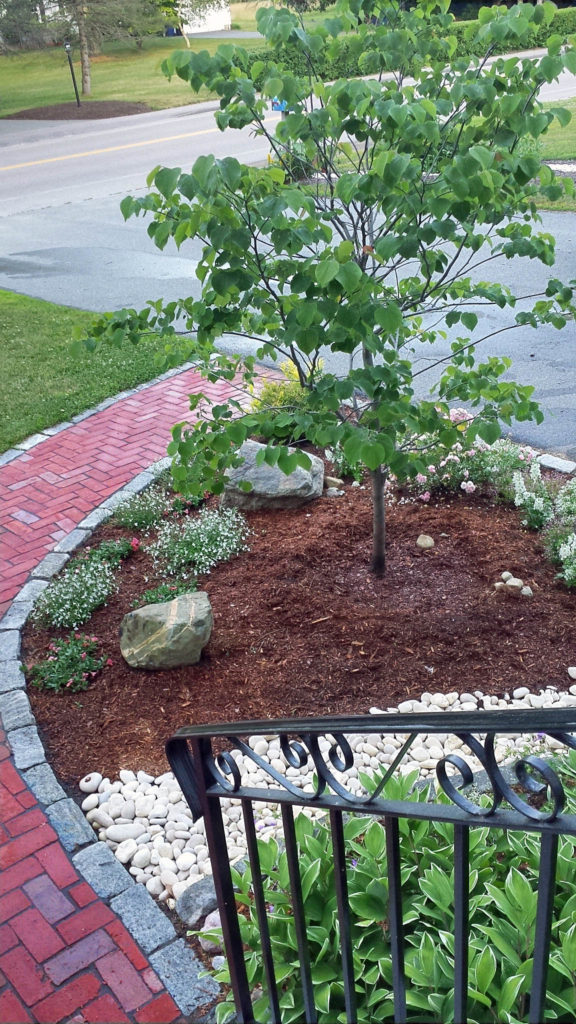
View from the front door of a redesigned front entry in Sharon, MA. What was a once a bare concrete landing and stairs is now adorned under a portico, with slabs of elegant granite on the landing and treads. At ground level, where you see a path of white river stones was once an asphalt walk from the driveway to the base of the stairs. The planted area was once lawn, and there was no brick path lined with cobblestones.
All these design changes improved the circulation around the home, as well as the curb appeal.
Plantings include a MA native redbud tree, Cercis canadensis, and a ground cover of variegated solomans seal.
For more informatoin about giving the front of your home a face lift, visit https://www.garden-911.com/
LESSONS LEARNED WHEN FIELD BOTANY MEETS DESIGN – MARCH 7

Uli Lorimer, Curator of the Native Flora Garden at Brooklyn Botanic Garden, will present Lessons Learned When Field Botany Meets Design at Grow Native Massachusetts’ Evenings with Experts lecture series at the Cambridge Public Library, Wednesday March 7 from 7:00 – 8:30 pm.
Evenings with Experts | Uli Lorimer | March 7 | Grow Native Massachusetts | Cambridge Public Library
Uli Lorimer, Curator of the Native Flora Garden at Brooklyn Botanic Garden
Ecologically attuned designers are increasingly looking to nature for inspiration in the design of managed landscapes. But connecting field botany to horticulture is complex, and insights gained from observations in the wild don’t always translate directly into a cultivated garden.
Uli will use the recently expanded native flora garden at Brooklyn Botanic Garden, a cultivated pine barrens and coastal plain grassland, as a case study— sharing lessons learned along the way as the project evolved from a concept into a dynamic, living landscape. Good design allows for change and succession to occur, and flexibility in design intent is a valuable strategy because things do not always work out as planned.
Uli Lorimer has been the Curator of Native Flora at the Brooklyn Botanic Garden Garden for over a decade. He was instrumental in the expansion of the Garden’s native plant collection, using only material sourced from the wild and grown from seed. As Field Chair at BBG, he coordinates fieldwork with regional botanists and leads botanical expeditions for naturalists and horticulturists.
This lecture is co-sponsored by Mount Auburn Cemetery
THE BEAUTIFUL ADAPTATIONS OF NATIVE PLANTS EVENT FEB 7th
Eager to learn more about native plants? Join Grow Native Massachusetts‘ Evenings with Experts this winter!
This free public lecture series is held at the Cambridge Public Library on the first Wednesday of each month, from February through May from 7:00 — 8:30 pm.
On February 7, Dan Segal, owner of The Plantsmen Nursery, will present The Beautiful Adaptations of Native Plants: Inviting the Wild into our Gardens.
Native plants have evolved a broad array of adaptations in the wild, yielding not only the ornamental features embraced in horticulture but many fascinating mechanisms for survival. Dan will take us beyond ‘pretty’ plant features to explore the origins of these adaptive traits, and the critical importance of regional variation. This insight helps us to select plants that are genuinely suited to our landscapes. He will also compare and contrast large-scale nursery production that favors the cloning of cultivars, with small-scale nursery propagation that favors seed-grown straight species. To know and source native plants effectively, understanding their propagation can be just as important as species selection.
As the owner of The Plantsmen Nursery, Dan Segal specializes in native plants, local seed collection, and natural landscaping. Dan has collected and propagated over 1,000 species of native plants in his three decades of work as a nurseryman, giving him great insight into the fascinating variety of adaptations that plants have evolved to survive. His nursery is in Ithaca, NY, where founded the Ithaca Native Plant Symposium in 2009.
HOW TO DESIGN YOUR GARDEN FOR WINTER INTEREST
How to design your landscape for winter interest? Here are a few concepts and suggestions. A professional designer can select the best plant materials for your site and especially, your lifestyle.
- first, consider your outdoor lifestyle and circulation around your property
- anchor your landscape design with evergreens that contrast one another in shape, size and color (in addition to needled and broadleaf)
- add deciduous shrubs with striking twig colors
- add a few grasses and perennials for flavor
- as always, make sure all your plant selections will thrive in the existing cultural conditions of your particular planting area (sun, soil, water, wind, drainage, etc.).
- native trees, shrubs, perennials, and grasses often do best in our area, as well as being the best choices for supporting pollinators
IS IT TOO LATE TO PLANT…IN THE SNOW?
What am I doing planting in the snow? After a robust season of gardening for others, I’m still catching up with my own home gardening by getting inkberry in the ground before the earth freezes up for good.
Inkberry (Ilex glabra) is a New England native plant that supports pollinators and other wildlife. In the holly family, these particular female Ilex glabra shrubs have nice dark berries that birds love. The red berries? This is a female winterberry, another native shrub in the holly family (Ilex verticillata), especially important to birds migrating in the spring.
Since I’m planting so late here in North Easton, I’ll apply about two gallons of water, delivered in small gulps, then cover the planting area with a thick but fluffy layer of leaves for insulation for the winter. Until the ground freezes, they’ll need about an inch of water every week, so I’ll continue watering as needed.
WANTED: DEAD NOT ALIVE Invasive Plants Exhibit Wins Educational Excellence Award
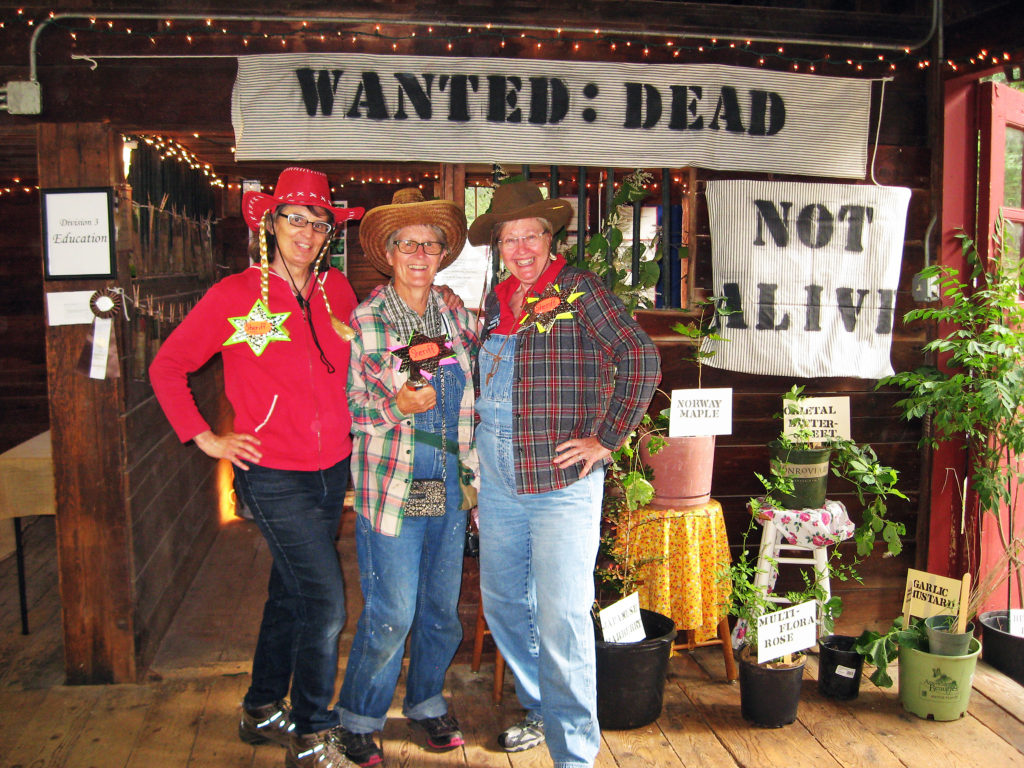
WANTED: DEAD NOT ALIVE received an Educational Excellence award at the Sharon Garden Club’s September Garden Medley on September 9, 2017. The exhibit featured potted exotic invasive plants and illustrated some of the environmental damage they cause. Left to right are Carol Lundeen of Easton and Brenda Minihan and Ellen Schoenfeld-Beeks of Sharon. The trio played roles as invasive plant sheriffs, engaging visitors in conversation and offering invasive plant checklists, images, and ideas for native plant alternatives. Photo by Carol Lundeen.
WANTED: DEAD NOT ALIVE received an Educational Excellence award at the Sharon Garden Club’s September Garden Medley on September 9, 2017. The exhibit featured potted exotic invasive plants and illustrated some of the environmental damage that invasives cause. Carol Lundeen of Easton and Brenda Minihan and Ellen Schoenfeld-Beeks of Sharon played roles as invasive plant sheriffs, engaging visitors in conversation and offering invasive plant checklists, images, and ideas for native plant alternatives.
Exotic invasive plants have no natural predators and diseases that would naturally control their growth. Some invasive plants have escaped from our home gardens and public plantings into natural areas and cause profound environmental and economic damage. Massachusetts has developed a list of problematic plants. Some are even illegal to sell, including Norway maple, Japanese maple, burning bush, all hollow-stemmed honeysuckles, garlic mustard, oriental bittersweet, and Japanese knotweed.
The exhibit also included a “Talking Tree,” a young pin oak tree that posed the question, “When I turn one hundred years old, what do you hope I will say?” Visitors then wrote their answers on a card and tied their card to the tree with yarn. The tree will be planted at the Unitarian Universalist Church in the center of Sharon.
The sheriffs urge folks to learn about the species considered invasive in the area, generate a list of those on your property or in your town, create a plan for eliminating them, and execute your plan. Contact the Sharon Garden Club or Carol Lundeen for further information.
Native plants + native bees = gardening success
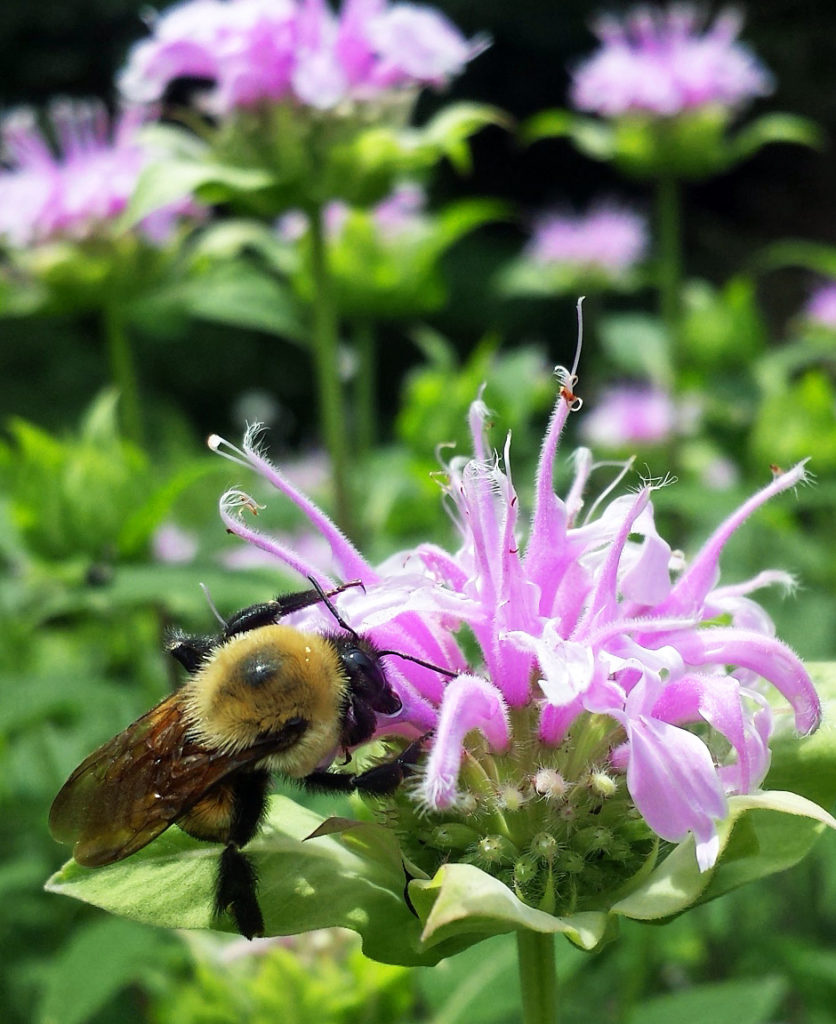
A native bee harvests nectar from native bee balm, or Monarda, in a Sharon, MA perennial and pollinator garden.
My general idea of a successful organic garden is to plant the right native plant in the right place in the right plant and soil community and let nature have its way. Native plants thrive in our native soils, support the local ecosystem by helping our birds and bees thrive.
Just today in my backyard I observed a wren arriving at its birdhouse with a caterpillar and heard the choir of baby wrens competing with open mouths for that nutritious meal.
Think about it. Everything we eat was once a plant, and without insects such as caterpillars and bees, we’d have no plants and no food. So plant a native next time, and you’ll be doing yourself and your neighboring ecosystem a big favor.
TOP 5 GARDENING TIPS FOR APRIL
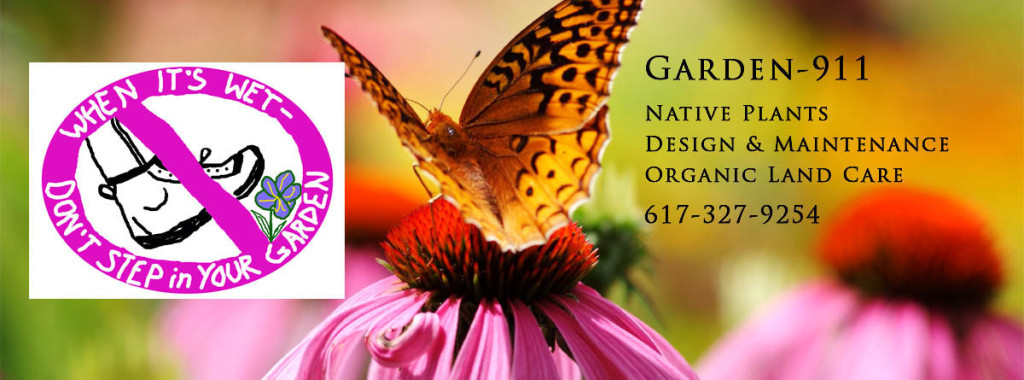
A note from a friendly frittilary butterfly: stepping in your garden or working on your lawn when the soil is wet damages your plants’ ability to thrive. (Image 2017 Carol Lundeen. ALL RIGHTS RESERVED)
#1. CAUTION: WET SOIL – DO NOT ENTER YOUR GARDEN – OR WORK ON YOUR LAWN!
- Our recent rains have left our soils saturated, and if you step into your shrub and garden beds now you’ll be causing mostly invisible but meaningful damage that makes it harder for your plants to thrive.
- Compacting your soil: plant roots depend on the spaces between soil particles to hold water and oxygen. When you step on wet soil, you compact these spaces and your plants suffer.
- One cup of soil may hold as many bacteria as there are people on Earth, never mind the fungi, protozoa, nematodes, arthropods, and earthworms – most of which are beneficial to you most of the time. Together, these tiny beings are a living system called the Soil Food Web, and it’s best to not to step on them when the soil is wet.
- To test if your soil is dry enough, take a handful of soil and squeeze it. If the soil crumbles easily when you open your hand, it is ready to be walked on or tilled. If it does not crumble, it is too wet. Allow the soil to dry for a few more days and test again before digging.
#2. GET YOUR SOIL TESTED – BEFORE YOU PLANT!
- Before planting is a good time to get a Routine Soil Analysis from the UMass Soil and Plant Nutrient Testing Lab to check pH and fertility. This economical soil test will provide recommendations for liming and fertilizing as needed, as well as indicating the lead level in the soil.
#3. START YOUR COOL-SEASON VEGETABLES – ONCE THE SOIL DRAINS!
- Now is a good time to sow seeds of cool season crops such as peas, lettuce, chard, kale, arugula, spinach, carrot, radish, beet and turnips.
- Plant the seeds as soon as the ground can be worked. Sow your spinach, beets, radish, carrots and lettuce thickly in rows and thin later to the desired spacing (read the label) and to allow them to develop properly. Root crops such as carrots, beets, and radishes should be thinned to a 2-inch spacing to allow the roots to develop properly. They can be thinned as soon as they reach small edible size.
#4. EAGER TO JUMP START YOUR LAWN?
- Your doctor wouldn’t give you a treatment without first making a diagnosis, right? Same goes with your lawn. Why treat your lawn for grubs or other turf insects if you don’t first discover what’s causing a problem? Grub populations are easy to evaluate, as are other sub-surface and surface insects. Once you diagnose properly, you can treat with a reasonable solution rather than automatically throwing money and chemicals at the situation.
- Start weaning your lawn off the expensive, stepped conventional petrochemical-based fertilizers by switching to a slow release, low-nitrogen organic fertilizer like Roots Fresh Start. Apply once in early spring after the soil has begun to warm up and apply again in early fall. The water-insoluble nutrients will be recycled and released by your friendly soil microbes slowly over the entire growing season as they’re needed by your turf, rather than getting flushed (along with your money) away with rain and any irrigation.
- Doing a lawn renovation this year? Wait until September for best results and return on your investment.
#5. MONITOR FOR WINTER MOTH CATERPILLARS
- Winter moth caterpillars cause damage to many different deciduous plants such as oaks, maples, cherries, ash, crabapples, apples and blueberries. their eggs typically hatch early-mid April, and the young larvae quickly start feeding on flower buds, leaf buds and young developing leaves.
- Winter moth egg hatch has not yet been observed for this growing season as of 4/5/17 in Massachusetts. Scouts are still reporting that winter moth eggs are orange in color and have not yet turned the blue color that indicates hatch is imminent. Eggs can be sprayed with dormant oil before they hatch, but the eggs can hide under pieces of bark and be hard to reach with spray.
- Once the caterpillars hatch, they’re eager to eat their host plants. Dormant oil will no longer work, but there’s a fairly safe treatment that simply takes their appetite away. It’s a kind of bacteria called bacillus thuringiensis var. Kurstaki. In some forms it’s approved for use on organic farms. Always read and follow the label.
(BONUS #6.) CELEBRATE ARBOR DAY BY PLANTING A TREE ON APRIL 28
- Arbor Day is an annual observance that celebrates the role of trees in our lives and promotes tree planting and care. The best tree selection may be a native tree that is well suited to thrive in your yard with your existing soil, sun, water, and other cultural conditions. Have your soil tested before investing in your new tree or shrub.
AS ALWAYS,PLEASE FEEL FREE TO CONTACT ME IF YOU HAVE ANY QUESTIONS OR NEED A HAND!
EMAIL CAROL OR CALL 617-327-9254

